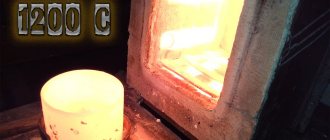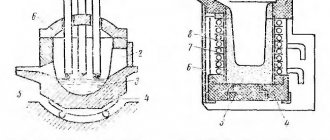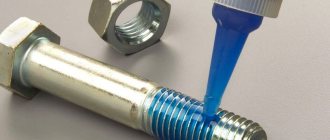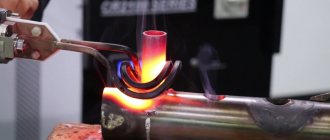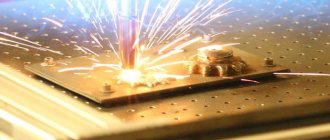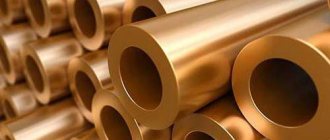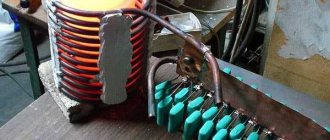Induction furnaces for metal melting
Principle of operation
Induction heating is the basis for the operation of the furnace. In other words, electric current creates an electromagnetic field and produces heat, which is used on an industrial scale. This law of physics is studied in the last grades of secondary school. But the concept of an electric unit and electromagnetic induction boilers should not be confused. Although the basis of work here and there is electricity.
How does this happen
The generator is connected to an alternating current source, which enters it through an inductor located inside. The capacitor is used to create an oscillation circuit, which is based on a constant operating frequency to which the system is tuned. When the voltage in the generator increases to a limit of 200 V, the inductor creates an alternating magnetic field.
The circuit is closed, most often, through a ferromagnetic alloy core. The alternating magnetic field begins to interact with the workpiece material and creates a powerful flow of electrons. After the electrically conductive element enters into the inductive action, a residual voltage , which in the capacitor contributes to the occurrence of an eddy current. The energy of the eddy current is converted into thermal energy of the inductor and the desired metal is heated to high melting temperatures.
The heat produced by the inductor is used:
- for melting soft and hard metals;
- for hardening the surface of metal parts (for example, tools);
- for thermal treatment of already produced parts;
- household needs (heating and cooking).
How to use safely
It is quite easy to get burned from the structure and molten metal, so you need to work with a homemade installation carefully. The circuit of the lamp sample involves the use of high voltage, without a good housing, any touch can result in an electric shock.
Clothes should not have metal inserts, because the electromagnetic field will affect them. A high-quality induction furnace, designed with your own hands, can heat elements quite efficiently, which will be convenient for tinning or molding. Experts do not recommend working with the equipment for people who have implanted pacemakers.
Brief characteristics of various furnaces
Types of devices
- Crucible induction furnaces are used to melt metals; their main principle, different from the operation of other units, is the absence of a core.
- Channel induction units are a kind of transformer that has a steel tip - a magnetic drive. The load is supplied through the secondary winding, made of one turn.
- Vacuum induction devices, in which the melting process is performed under conditions of complete vacuum, which literally draws out all impurities from the metal.
- Melting crucible furnaces are inductors for a melt mass from 5 to 200 kg with a converter based on the transistor principle.
Species and subspecies
Induction furnaces are divided into two main types:
- Duct. In it, the secondary turn is a circular short-circuited channel into which the metal is placed. A generator or alternating current of industrial frequency is used as an energy source for the smelting process. The high efficiency of such furnaces is due to the transmission of a high-frequency field through a ferrite or steel core. Steel melting in induction furnaces of this type is characterized by the continuous supply of metal blanks and the production of molten metal. The only drawback of the channel unit is the difficulty of starting its operation, since it is first necessary to fill the channel with the melt.
- Crucible. In such furnaces, the energy source is a generator that can operate in the range from several tens to hundreds of kHz. Metal blanks in this type of furnace are placed in its heat-resistant crucible, which is located in the inductor winding. As soon as the melt reaches the desired temperature, the crucible is emptied and filled with the next batch of raw materials. Such a furnace device is characterized by a high rate of heating of the metal, since heat loss in the crucible is very small.
In addition to this division, induction furnaces are compressor, vacuum, open and gas-filled.
Induction crucible furnaces
It is the most common type of induction heating furnace. A distinctive feature that differs from other types is that an alternating magnetic field appears in it in the absence of a standard core. A cylinder-shaped crucible is placed inside the inductor cavity . The furnace, or crucible, is made of a material that perfectly resists fire and is connected to alternating electric current.
Positive aspects
- energy is released when loading metal, there is no need to install intermediate elements;
- metal alloys consisting of several components, after completion of melting, obtain a uniform consistency and the same chemical composition in any selected volume;
- with the help of pressure regulators it is possible to carry out a reducing, oxidative or neutral process;
- medium frequencies of alternating current show high specific power values, which puts crucible furnaces among the high-performance units;
- the furnace can operate with breaks between loading metal, this will not affect subsequent melting, the transition from one type of metal to another occurs without lengthy reconfiguration of parameters;
- crucible units are easy to set to automatic control, they are simple to operate and can be easily adjusted to any of the modes;
- As a result of the process, high-quality slurries are obtained, consisting of many components, the temperature is constant and the same within the bath, and residues and waste are quickly melted, there is no overheating.
Crucible units are classified as environmentally friendly heat sources ; the environment is not polluted by metal melting.
There are disadvantages in the operation of crucible furnaces:
- during technological processing, slags at low temperatures are used;
- The produced lining of crucible furnaces has low resistance to destruction, this is most noticeable during sudden temperature changes.
The existing disadvantages do not pose any particular difficulties; the advantages of a crucible induction unit for melting metal are obvious and have made this type of device popular and in demand among a wide range of consumers.
Historical reminders to note
The noted melting technique is used in industry, medicine, and the domestic sphere, due to the pronounced advantages compared to traditional heating methods:
- resistive,
- fiery,
- stove and others.
Induction heating is especially useful for high-precision or repetitive applications.
Induction heating was first used by Michael Faraday, a physicist and chemist from Great Britain. The scientist discovered a unique heating property while studying the induction of currents in wires under the influence of a magnet.
However, the basic principles of induction heating were presented a little later by James Maxwell in a unified theory of electromagnetism. At the same time, James P. Joule was the first to describe the heating effect of current flowing through a conductive material.
In 1887, Sebastian Ziani de Ferranti proposed induction heating as a method for melting metals. The first fully functional induction furnace was built and introduced to the public (1891) by F. A. Kjellin. The first application of a high-frequency furnace was realized by Edwin F. Northrup (1916).
The development of solid-state oscillators using new power semiconductor technologies has provided potential beyond the industrial environment. Since the late 1980s, various proposals for use have appeared.
In recent years, there has been particular interest in induction heating for medical procedures, since this method provides accurate and targeted local heating.
Channel induction melting furnaces
This type is widely used in the smelting of non-ferrous metals.
Effectively used for copper and copper alloys based on brass, cupronickel, bronze. Aluminum, zinc and alloys containing these metals are actively melted in channel units. The widespread use of furnaces of this type is limited due to the inability to provide a fracture-resistant lining on the inner walls of the chamber. Molten metal in channel induction furnaces undergoes thermal and electrodynamic movement , which ensures constant uniformity of mixing of alloy components in the furnace bath. The use of channel furnaces of the induction principle is justified in cases where special requirements are imposed on the molten metal and manufactured ingots. The alloys are of high quality in terms of gas saturation coefficient and the presence of organic and synthetic impurities in the metal.
Channel induction furnaces operate like a mixer and are designed to level the composition, maintain a constant process temperature, and select the pouring speed into crystallizers or molds. For each alloy and casting composition, there are parameters for a special charge.
Advantages
- the alloy is heated in the lower part, to which there is no air access, which reduces evaporation from the upper surface, heated to a minimum temperature;
- channel furnaces are classified as economical induction furnaces, since the melting that occurs is ensured by a low consumption of electrical energy;
- the furnace has a high efficiency due to the use of a closed loop magnetic wire;
- Constant circulation of molten metal in the furnace accelerates the melting process and promotes uniform mixing of alloy components.
Flaws
- the durability of the stone internal lining decreases when high temperatures are used;
- the lining is destroyed when melting chemically aggressive alloys of bronze, tin and lead.
- when melting contaminated low-grade charge, the channels become clogged;
- the surface slag in the bath does not heat up to a high temperature, which does not allow operations to be carried out in the gap between the metal and the shelter and to melt chips and scrap;
- channel units do not tolerate interruptions in operation, which forces them to constantly store a significant amount of liquid alloy in the furnace mouth.
Complete removal of molten metal from the furnace leads to its rapid cracking. For the same reason, it is impossible to quickly change from one alloy to another ; you have to make several intermediate melts, called ballast.
Induction heating technology innovation and future development
Even though induction heating systems have already reached maturity as a technology, the development of modern technologies is constantly accompanied by opportunities for new areas of research.
The coming years promise to include the following topics, which are expected to be of significant interest to the industrial sector.
Improving application efficiency
Advances in semiconductor manufacturing technology promise higher efficiency induction heating systems. In addition, special inductor shapes and designs will also ensure increased efficiency of the technology.
As a result, improvements can be expected not only in terms of performance, but also in terms of reliability of induction heating systems.
Industrial machines related to the described technology, that is, those that support induction heating, have been actively improved for the last few years
Process heaters equipped with several coils are:
- better heat distribution,
- higher productivity,
- process flexibility,
when using several simultaneously operating coils.
Such systems represent a significant technological breakthrough and are increasingly used not only in industry, but also in the domestic sector. However, it is not without problems.
Thus, efforts should be made to optimize the multi-output power converter design and advanced control algorithms. Another issue to carefully consider is the coupling effect between the individual coils.
Vacuum induction furnaces
This type is widely used for melting high quality steels and heat-resistant nickel, cobalt and iron alloys. The unit successfully copes with the melting of non-ferrous metals. Glass is melted in vacuum units, parts are treated at high temperatures, and single crystals are produced .
The furnace is classified as a high-frequency generator located in an inductor isolated from the external environment, passing a high-frequency current. To create a vacuum, air masses are pumped out of it with pumps. All operations for introducing additives, loading the charge, and dispensing metal are carried out by automatic mechanisms with electrical or hydraulic control. Alloys with small admixtures of oxygen, hydrogen, nitrogen, and organics are obtained from vacuum furnaces. The result is far superior to open induction ovens.
Heat-resistant steel from vacuum furnaces is used in tool and weapons production . Some nickel alloys containing nickel and titanium are chemically active, and it is problematic to obtain them in other types of furnaces. Vacuum furnaces perform metal pouring by rotating the crucible in the internal space of the casing or by rotating the chamber with a fixed furnace. Some models have an opening hole in the bottom to drain metal into an installed container.
Vacuum melting plant
An induction-type vacuum device consisting of a chamber, an induction furnace and a casting mold is suitable for melting and casting. The positive qualities of the device include the ability to obtain high-quality products at minimal production costs. The principle of operation of a vacuum furnace is based on an improved technology for melting metals with increased degassing, the possibility of recharging the installation, adjusting the temperature regime, changing the chemical composition and deoxidation of the material in the working process.
The technological process makes it possible to obtain high-purity alloys, reduce heating and melting times, and use any form of raw materials. Vacuum-type devices can operate from an alternating network ; the final product is an alloy with a reduced percentage of hydrogen and nitrogen; the purity of the material is obtained by pumping air from the melting chamber and cleaning the metal from volatile components present in the charge.
Crucible furnaces with transistor converter
Used for limited weight non-ferrous metals. They are mobile, light in weight and can be easily moved from place to place. The furnace package includes a high-voltage transistor converter with universal action .
Allows you to select the power recommended for connecting to the network, and, accordingly, the type of converter that is needed in this case with changing the weight parameters of the alloy. Transistor induction furnace is widely used in metallurgical processing. With its help, parts are heated in blacksmithing and metal objects are hardened. Crucibles in transistor furnaces are made of ceramics or graphite; the former are designed to melt ferromagnetic metals such as cast iron or steel. Graphite is installed to melt brass, copper, silver, bronze and gold. They melt glass and silicon. Aluminum melts well using cast iron or steel crucibles.
Cooling
This question is probably the most difficult of all those that are posed to a person who decides to independently assemble a melting apparatus based on the induction principle. The fact is that it is not recommended to place the fan directly next to the stove. Metal and electrical parts of the cooling device can adversely affect the operation of the stove. A fan located far away may not provide the necessary cooling, which will lead to overheating.
The second option is to carry out water cooling. However, performing it efficiently and correctly at home is not only difficult, but also not financially profitable. In this case, it’s worth thinking about: wouldn’t it be more economical to purchase an industrial version of an induction furnace, produced at a factory, in compliance with all the necessary technologies?

